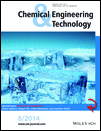Mass Transfer and Kinetics Study of Heterogeneous Semi-Batch Precipitation of Magnesium Carbonate
Abstract
Precipitation kinetics and mass transfer of magnesium carbonate (MgCO3) hydrates from a reaction of magnesium hydroxide (Mg(OH)2) and CO2 were analyzed. The effect of CO2 flow rate and mixing intensity on precipitation was investigated under ambient temperature and atmospheric pressure. Raman spectroscopy was used to determine the composition of the solids during semi-batch crystallization. The obtained spectra revealed the dissolution of Mg(OH)2 and the formation of MgCO3. The precipitation rate increased with higher gas flow rate. The rotation speed of the stirrer had a significant effect on the dissolution of Mg(OH)2. In the researched system, the main driver of the precipitation kinetics was the mass transfer of CO2. Nesquehonite (MgCO3·3H2O), as needle-like crystals, was precipitated as the main product. Raman spectroscopy can serve as a potential tool to monitor the carbonation precipitation process.




